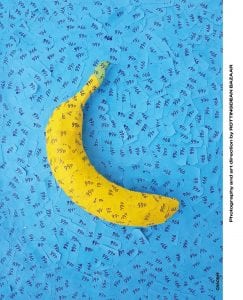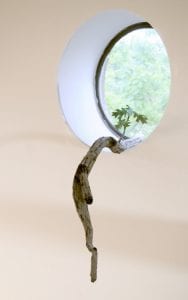Rouge Fashion Book
Rouge magazine is a biannual fashion book; first of its kind found in china. They showcase topics on fashion and art culture supported by highly established designers and artists to coincide with their modern photography styles and fashion forward content. The fashion photography conveyed in the Chinese fashion book is has a similar aesthetic to Off Black; using definitive fashion styles such as portraiture images and style shots, but the combination of this alongside captivating layout styles creating a more intriguing feel to their magazine. Figure 32 is part of a series of images combining fashion photography and graphic design, creating a dynamic image that creates an individualisation to the accompanying content. This sort of imagery is something that I am interested in including in my magazine which expand upon static journalism.
Figure 30 is another representation of interesting layout possibility that I want to fuel my publications visual identity. The spread in Figure 30 combines 3 images from the same shoot, using these images to show diversity through the narrative which allows the reader to fully engage with this through one spread in the magazine. When comparing this magazine to other fashion books like Off Black, there is a strong presence in regard to vibrancy and vividness; this being conveyed through the bright colour pallets that run through each image. This is also made more prominent with by the support of black and white imagery which I think is effective way of incorporating the reader. Rouge is a hard-back book which sets itself apart from other magazines, using hardback as part of its identity follows the idea that it will be a publication of longevity, unlike other magazines which are read a number of times then discarded. This is something to consider for my publication as it a definite design feature that I want to include, however, the costing of this will impact on the magazine’s marketability.
The September Issues

The September Issues are a feminist magazine, printed independently showcasing artists and creatives to establish fashion as a feminist issue whilst also allowing for new talent to publish themselves into the industry in a engaging and diverse format. The aim for their publication is to engage with an audience that have an interest in fashion and the arts whilst also including political and social topics which can help educate and inform; creating a visual impact on their reader. This ethos I want to project into my upcoming publication; creating content that is visually engaging and captivating whilst also impacting on the readers though process, questioning what they are looking at which I feel this magazine is doing effectively. In comparison to Rouge, Chaos and Off Black, this magazine has a more definitive identity with their imagery, with the others exuding high fashion photography incorporating desirable designers,
The September Issues’ aesthetic is more relatable, using softer tones and lighter accents of colour to attract their target audience with subtly and compassion. Figure 38 is an example of photography that helps the reader with relativity with a static publication like a magazine. The use of portraiture photography like this one assists with the association to the content they are reading; putting a face to the name. This is something that will be made prominent through my magazine, using realistic and modern beauty standards if this type of content was included, to show diversity and inclusion. The September Issues is a similar size to Off Black, using this to also convey their relatability in their ethos. The use of bright colours helps with identification; having a strong front cover shown in Figure 35 is a viable design decision with the publication being independently published, which I something I will need to consider further.













































